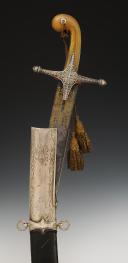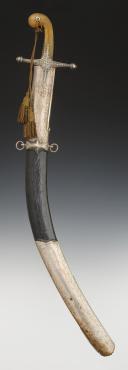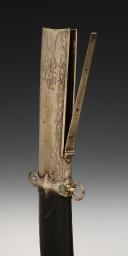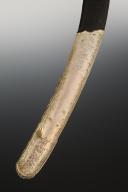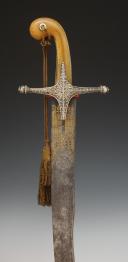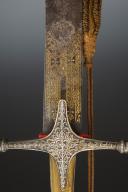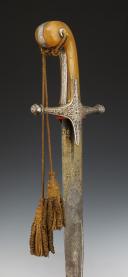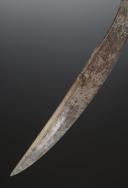
Officer's saber in Oriental style, Pala type, First third of the 19th century. 30224
Sold out
OFFICER SWORD IN ORIENTAL STYLE, PALA TYPE, First third of the 19th century. 30224
Silver-plated metal hilt with two horizontal quillons, richly decorated with foliate patterns. Wooden handle with horn scales and a transversal perforation at the top allowing the passage of a lanyard cord, with a side rod in engraved silver-plated metal adorned with foliate patterns. Curved blade with hollow facets, length 76.5 cm, engraved and gilded with Arabic inscriptions along its spine. Scarlet cloth knot.
Wooden scabbard covered in black waxed calf leather with two large silver-plated brass fittings engraved with foliate patterns.
Lanyard with double tassel in golden passementerie.
France.
First third of the 19th century.
Good condition.
PROVENANCE:
According to family tradition, this sword belonged to General Cazals.
HISTORICAL BACKGROUND:
Louis-Joseph Elisabeth Cazals (1774 - Castelnaudary ✝ 1813) was a French military officer in the 18th and 19th centuries. Louis-Joseph Elisabeth Cazals began his service as an assistant in the engineering corps on September 27, 1793, participating in campaigns during the Committees of Public Safety and later being appointed lieutenant and captain on the 1st of vendémiaire and the 14th of ventôse in the Year III.
He contributed to the relief of Maubeuge, witnessed the sieges of Nieuport, Sluis, 's-Hertogenbosch, the crossing of the Meuse, and the capture of the island of Bommel. He directed the capture of the last two operations with courage and intelligence. He distinguished himself at the siege of Nijmegen and the capture of its outworks, as well as at the siege of Heusden, which he led alone, and in the conquest of Holland. His conduct was no less brilliant at the crossing of the Rhine, at Uerdingen, and before Mainz. Tasked with constructing the fortified camp of Düsseldorf, he put this place in a defensive state shortly after its foundation, as well as Kayserwert. Called to command the left wing engineering of the army led by Kléber, this general entrusted him with the establishment of 60 leagues of roads between the Meuse and the Rhine.
During the Year IV campaign, Captain Cazals was involved in the crossing of the Sieg, the battles of Uckerath, Altenkirchen, Friedberg, the capture of Rothenberg, the skirmishes of Sulzbach and Amberg. The army, attacked by superior forces and forced to retreat, could only do so through two pontoon bridges. Cazals was tasked with establishing them, and these two constructions were completed in a single night. At the end of the military operations of the campaign, he received congratulations from the Minister of War.
In Year V, he commanded the engineering of the left wing of General Championnet's army. On the 8th of germinal, the government rewarded his services with a promotion to the rank of battalion chief. Cazals was selected to join the Army of the Orient. He proudly participated in the capture of Malta, the attack and seizure of Alexandria, the battle of Chebreiss, and the battle of the Pyramids. General Bonaparte, reporting to the Directory on his military operations in the East, highlighted battalion chief Cazals for his exceptional performance. In the Year VIII, General Kléber entrusted him with the command of the El-Arish fortress, where he was besieged by the Grand Vizier's army of 60,000 men. For eight days, he vigorously resisted before the army. He was mentioned on the army's order of the day on the 15th of germinal for his valor, activity, and particularly the effective means he used on the 4th of nivôse. On the 11th of germinal, the Commander-in-Chief appointed him colonel of the engineering corps. That same year, he took part in the battle of Heliopolis and the siege of Cairo. On the 18th, 22nd, and 30th of ventôse in the Year IX, he was present at the battles near Alexandria and commanded the engineering of the entrenched camp protecting the city.
Silver-plated metal hilt with two horizontal quillons, richly decorated with foliate patterns. Wooden handle with horn scales and a transversal perforation at the top allowing the passage of a lanyard cord, with a side rod in engraved silver-plated metal adorned with foliate patterns. Curved blade with hollow facets, length 76.5 cm, engraved and gilded with Arabic inscriptions along its spine. Scarlet cloth knot.
Wooden scabbard covered in black waxed calf leather with two large silver-plated brass fittings engraved with foliate patterns.
Lanyard with double tassel in golden passementerie.
France.
First third of the 19th century.
Good condition.
PROVENANCE:
According to family tradition, this sword belonged to General Cazals.
HISTORICAL BACKGROUND:
Louis-Joseph Elisabeth Cazals (1774 - Castelnaudary ✝ 1813) was a French military officer in the 18th and 19th centuries. Louis-Joseph Elisabeth Cazals began his service as an assistant in the engineering corps on September 27, 1793, participating in campaigns during the Committees of Public Safety and later being appointed lieutenant and captain on the 1st of vendémiaire and the 14th of ventôse in the Year III.
He contributed to the relief of Maubeuge, witnessed the sieges of Nieuport, Sluis, 's-Hertogenbosch, the crossing of the Meuse, and the capture of the island of Bommel. He directed the capture of the last two operations with courage and intelligence. He distinguished himself at the siege of Nijmegen and the capture of its outworks, as well as at the siege of Heusden, which he led alone, and in the conquest of Holland. His conduct was no less brilliant at the crossing of the Rhine, at Uerdingen, and before Mainz. Tasked with constructing the fortified camp of Düsseldorf, he put this place in a defensive state shortly after its foundation, as well as Kayserwert. Called to command the left wing engineering of the army led by Kléber, this general entrusted him with the establishment of 60 leagues of roads between the Meuse and the Rhine.
During the Year IV campaign, Captain Cazals was involved in the crossing of the Sieg, the battles of Uckerath, Altenkirchen, Friedberg, the capture of Rothenberg, the skirmishes of Sulzbach and Amberg. The army, attacked by superior forces and forced to retreat, could only do so through two pontoon bridges. Cazals was tasked with establishing them, and these two constructions were completed in a single night. At the end of the military operations of the campaign, he received congratulations from the Minister of War.
In Year V, he commanded the engineering of the left wing of General Championnet's army. On the 8th of germinal, the government rewarded his services with a promotion to the rank of battalion chief. Cazals was selected to join the Army of the Orient. He proudly participated in the capture of Malta, the attack and seizure of Alexandria, the battle of Chebreiss, and the battle of the Pyramids. General Bonaparte, reporting to the Directory on his military operations in the East, highlighted battalion chief Cazals for his exceptional performance. In the Year VIII, General Kléber entrusted him with the command of the El-Arish fortress, where he was besieged by the Grand Vizier's army of 60,000 men. For eight days, he vigorously resisted before the army. He was mentioned on the army's order of the day on the 15th of germinal for his valor, activity, and particularly the effective means he used on the 4th of nivôse. On the 11th of germinal, the Commander-in-Chief appointed him colonel of the engineering corps. That same year, he took part in the battle of Heliopolis and the siege of Cairo. On the 18th, 22nd, and 30th of ventôse in the Year IX, he was present at the battles near Alexandria and commanded the engineering of the entrenched camp protecting the city.
Reference :
30224
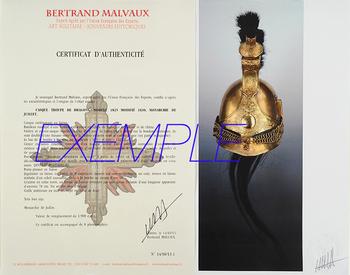
Next update Friday, december 26 at 13:30 PM
FOR ALL PURCHASES, PAYMENT IN MULTIPLE CHECKS POSSIBLE
bertrand.malvaux@wanadoo.fr 06 07 75 74 63
SHIPPING COSTS
Shipping costs are calculated only once per order for one or more items, all shipments are sent via registered mail, as this is the only way to have proof of dispatch and receipt.
For parcels whose value cannot be insured by the Post, shipments are entrusted to DHL or Fedex with real value insured, the service is of high quality but the cost is higher.
RETURN POLICY
Items can be returned within 8 days of receipt. They must be returned by registered mail at the sender's expense, in their original packaging, and in their original condition.
AUTHENTICITY
The selection of items offered on this site allows me to guarantee the authenticity of each piece described here, all items offered are guaranteed to be period and authentic, unless otherwise noted or restricted in the description.
An authenticity certificate of the item including the description published on the site, the period, the sale price, accompanied by one or more color photographs is automatically provided for any item priced over 130 euros. Below this price, each certificate is charged 5 euros.
Only items sold by me are subject to an authenticity certificate, I do not provide any expert reports for items sold by third parties (colleagues or collectors).
FOR ALL PURCHASES, PAYMENT IN MULTIPLE CHECKS POSSIBLE
bertrand.malvaux@wanadoo.fr 06 07 75 74 63
An authenticity certificate of the item including the description published on the site, the period, the sale price, accompanied by one or more color photographs is automatically provided for any item priced over 130 euros. Below this price, each certificate is charged 5 euros.
Only items sold by me are subject to an authenticity certificate, I do not provide any expert reports for items sold by third parties (colleagues or collectors).
